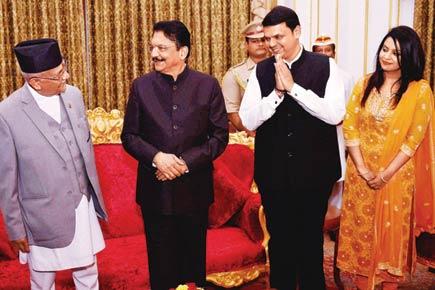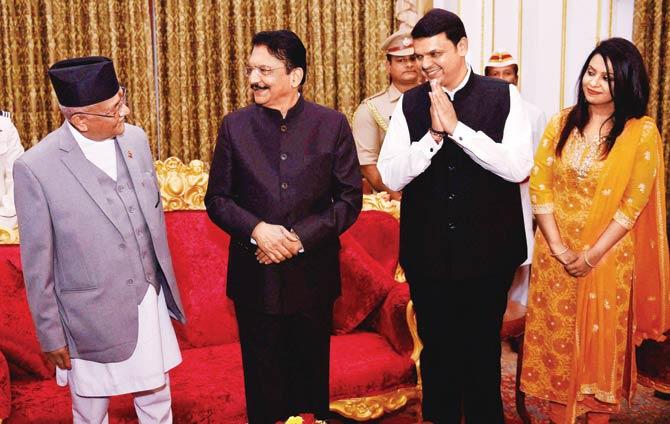The Nepal PM’s recent visit may not have restored the glow to bilateral relations but both he and the Modi government have gained through it

 The recent visit (February 19-24) of the Nepalese Prime Minister KP Sharma Oli has not quite restored the glow to India-Nepal ties. When Prime Minister Modi visited Nepal twice in 2014, he raised enormous expectations of a new era in India-Nepal ties which have never been as good as they should be, considering the unique relationship between the two countries. Geography has locked India and Nepal with each other and their historic and cultural ties have been burnished by the open border of a kind that no two countries in the world share.
The recent visit (February 19-24) of the Nepalese Prime Minister KP Sharma Oli has not quite restored the glow to India-Nepal ties. When Prime Minister Modi visited Nepal twice in 2014, he raised enormous expectations of a new era in India-Nepal ties which have never been as good as they should be, considering the unique relationship between the two countries. Geography has locked India and Nepal with each other and their historic and cultural ties have been burnished by the open border of a kind that no two countries in the world share.
 Nepal Prime Minister KP Sharma Oli meets Maharashtra Governor C Vidyasagar Rao, CM Devendra Phadnavis and his wife Amruta at Rajbhavan during his visit to Mumbai last Tuesday. Pic/PTI
Nepal Prime Minister KP Sharma Oli meets Maharashtra Governor C Vidyasagar Rao, CM Devendra Phadnavis and his wife Amruta at Rajbhavan during his visit to Mumbai last Tuesday. Pic/PTI
However, things went downhill in 2015. First there was the devastating earthquake that hit Nepal. India played a major role in providing relief, but that effort was marred by some over-the-top Indian media coverage that seemed to rub Nepal’s nose in the dirt. This was followed by the crisis around the new constitution promulgated in October 2015, which still persists because Madhesis, Tharus (who live in the plains area of Nepal) and the low-caste Janjatis oppose some of its provisions.
The constitution appeared to be a deal between the three ‘pahari’ or mountain-dominated parties — the Communist Party of Nepal (Unified Marxist-Leninist, UML), the Nepali Congress(NC) and the Communist Party of Nepal (Maoists). The three are traditional rivals, but they got together to foist a constitution which was deliberately weighted against the plains’ groups who now form anywhere between 30-50 per cent of the country’s population and have the capacity to play a “swing” role in Nepali politics. The resulting Madhesi agitation and blockade was supported by India, because New Delhi has long chafed at the attitude of the mountain parties who are all too ready to use anti-Indian rhetoric to score political points and, worse, use China to offset the Indian influence in Nepal.
Oli’s reaction to the Madhesi agitation was to take a hard-line position and accuse India of fomenting it. He sent several delegations to China to develop an alternate energy corridor. But China has always been cautious in taking on India in Nepal. It makes symbolic gestures, but when push comes to shove, it backs off for the simple reason that it is simply not worthwhile economically or politically to supplant India in Nepal.
Finally, on December 20, 2015, the Nepal Cabinet held an emergency meeting and agreed to make a deal with the Madhesi agitators on the issue of provincial boundaries and pass a constitutional amendment to provide for proportional inclusive participation of the Nepali people in the various state organs and the delimitation of the electoral constituencies on the basis of population.
Even then, India did not relent. It was only after the Nepalese Parliament endorsed the Constitution Amendment Bill that things began to move. Within hours of the end of the blockade on February 5, Nepal announced the visit of Prime Minister KP Sharma Oli to New Delhi. Oli said he was coming to India to remove the “misunderstanding” that had developed between the two countries. Later, he announced on February 19 that a high-level political committee would be set up to review provincial boundaries in a three-month time frame.
No joint statement issued following Oli’s six-day visit and officials say differences between the constitutional process to effect the changes that Nepal has promised remains. During the talks, the Nepali government gave assurances that the constitutional changes, the issue of boundaries and citizenship would be addressed in the coming months.
The Indian side welcomed the constitution, but noted that its success would depend on “consensus and dialogue” and the ability of the government to deal with the issues related to building the consensus. The Indian side also sought to learn a little bit more about the terms of reference of the mechanism that the Oli government had promised on December 20, 2015.
Both India and Oli have gained through the visit. Oli has signalled that he is acceptable to a key neighbour and hence, strengthened his own position within the Nepali politics. India, on the other hand, has managed to show that it can do business with Oli, and that China has not gained ground in Nepal at the cost of India.
The Modi government has also achieved its goal of convincing the Government of Nepal that India remains its primary interlocutor. India had pledged $1 billion in reconstruction aid, of which 40 per cent is in grants and the rest soft loans. During Modi’s visit in 2014 another $1 billion was promised over the next five years. India’s red line for dealing with Nepal relates to security. Given Nepal’s location, and the fact that the 1,800-km India-Nepal border is not militarily defended, means that India cannot afford to have a government in Nepal which is anti-Indian or, to be more precise, is not friendly to New Delhi.
The writer is a Distinguished Fellow, Observer Research Foundation, New Delhi
 Subscribe today by clicking the link and stay updated with the latest news!" Click here!
Subscribe today by clicking the link and stay updated with the latest news!" Click here!









